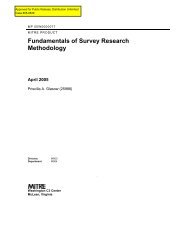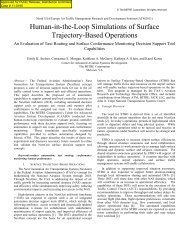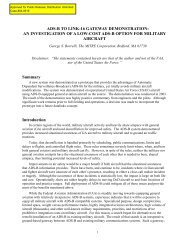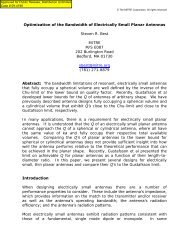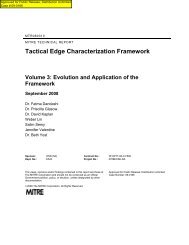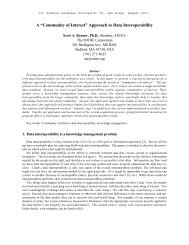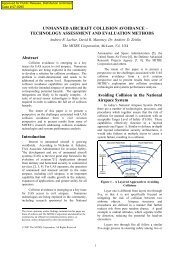A Predictive Model of User Equipage Costs for Future Air ... - Mitre
A Predictive Model of User Equipage Costs for Future Air ... - Mitre
A Predictive Model of User Equipage Costs for Future Air ... - Mitre
You also want an ePaper? Increase the reach of your titles
YUMPU automatically turns print PDFs into web optimized ePapers that Google loves.
5 Current <strong>Air</strong>craft <strong>Equipage</strong> States<br />
5.1 <strong>User</strong> Surveys<br />
As part <strong>of</strong> the work on ADS-B equipage we conducted surveys <strong>of</strong> the top airlines to determine<br />
specifically how their fleets were equipped. This in<strong>for</strong>mation along with data in the commercial<br />
ACAS database was used to identify capable and latent aircraft within each airline’s fleets.<br />
Surveys were provided to both the large air transport and regional carriers to determine the current<br />
configuration <strong>of</strong> the aircraft with respect to Mode-S transponders, GPS capability and installation<br />
capabilities to support ADS-B applications. Appendix C contains both the large air transport and<br />
regional carrier surveys that were sent out. Each <strong>of</strong> these surveys are different since the part<br />
numbers <strong>for</strong> transponders and GPS are different <strong>for</strong> the different types <strong>of</strong> aircraft.<br />
MITRE CAASD developed the surveys and completed the identification <strong>of</strong> the equipment part<br />
numbers. Johns Hopkins University Applied Physics Laboratory actually sent out the surveys and<br />
followed up with each airline to get the responses. For the large air transport, <strong>of</strong> the 23 airlines<br />
sent surveys we received replies from all except one airline. For the regional carriers 20 surveys<br />
were sent out and responses were received from 13 airlines.<br />
5.2 Commercial Databases<br />
Until lately, commercial databases <strong>of</strong> aircraft equipage did not contain the details on avionics<br />
equipage by model or part number. The available databases focused on other aircraft components<br />
like engines, Auxiliary Power Units (APUs), seats, and other replaceable mechanical or electrical<br />
equipment. Avionics configurations were not generally included with any level <strong>of</strong> detail.<br />
However, one commercial database provider did begin to collect and report data on avionics<br />
configurations by specific aircraft tail numbers. AvS<strong>of</strong>t has begun to provide avionics equipage<br />
details on a tail by tail basis <strong>for</strong> airlines around the world.<br />
The AvS<strong>of</strong>t database called ACAS was used in the MITRE analysis to determine the state <strong>of</strong><br />
equipage <strong>for</strong> GPS or MMR capability. The ACAS provided the necessary equipage details <strong>for</strong><br />
those aircraft identified in the airline surveys that are equipped with Mode-S transponders. This<br />
allowed us to estimate and group the number <strong>of</strong> aircraft with the necessary elements to achieve<br />
ADS-B either as latent, equipped or not equipped.<br />
5.3 OEM Discussions<br />
Several discussions were held with avionics OEMs to determine the specific details <strong>of</strong> their<br />
products as they apply to ADS-B. These conversations provided very useful in<strong>for</strong>mation on the<br />
specific type and part numbers that are capable <strong>of</strong> or upgradeable to ADS-B functionality. This<br />
in<strong>for</strong>mation was used in developing in<strong>for</strong>mational materials <strong>for</strong> the airline surveys so that<br />
adequate details about the equipment and capabilities were properly reported.<br />
5-1



